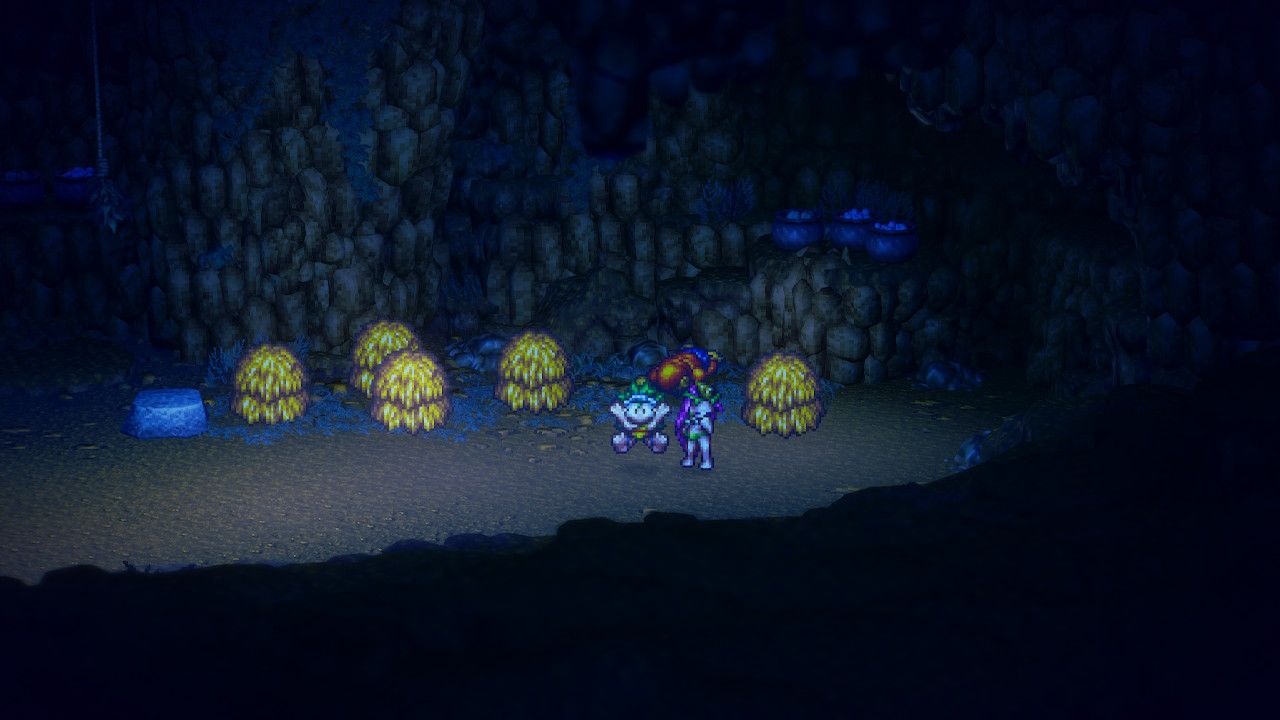Live A Live and Its Wordless Prehistory
Examining the concept of "ludonarrative consonance" in Live A Live

ilding on a game of the same name released in 1994 and originally written and directed by Takashi Tokita, Team Asano’s remake of Live A Live has an experimental and subversive narrative design in relation to the long tradition of JRPGs. The plot has no unity, except at the end, thanks to a miraculous artifice. In addition, it is a compilation of short stories, each with a gameplay suited to its narrative proposal. One of the most interesting cases that resulted from this style of proposal is that of Prehistory.
Live A Live has eight subplots, each in a different time and space, and the one from Prehistory takes place in a cavernous environment with little vegetation, where a community of humans coexists without the use of spoken language. This choice is directly related to the concept of prehistory, the theme of the plot, and the gameplay. Thus, the execution of this phase of Live A Live is an excellent example for understanding coherence in game design, and that is what I will show in the next topics.

The concept of "ludonarrative consonance" and the proposal of Live A Live
This entire article is nothing more than a very nice case study of what is called ludonarrative consonance, which is a kind of coherence between two levels of game design: gameplay and narrative. This means that we say that a game has narrative consonance when the design choices for gameplay with playable characters are coherent with what the narrative tells about them.
The term “ludonarrative consonance” is a concept that emerged as an inversion of the term “ludonarrative dissonance”, coined by Clint Hocking (click nothing, 2007) in an review about Bioshock (2007), by Ken Levine. An example of narrative dissonance is, for instance, a game where the protagonist is extremely violent while, at the same time, their story frames them as someone who is both altruistic and peaceful.
If you want to delve into the more general concept of “coherence” in game design, I recommend checking out my article The Difference Between Cohesion and Coherence in Video Games (2022). Here I will limit myself to a less rigorous definition of this term. Basically, we can assume that a set of game design choices is coherent when it satisfies two requirements:
- if the design choices are in line with the proposal of what the game wants to communicate;
- whether the design choices within this set do not provide contradictory experiences with each other.
Thus, we need to start by clarifying the proposal of Live A Live in general, and the Prehistory phase in particular. Only then will we be able to see how the choices coincide with the proposal. Fortunately, as I have already written an review of this game (Portuguese), I have also presented its general proposal.
"Live A Live brings a double proposal of game design. On the one hand, it is born from a questioning in relation to game genres, but not in the sense of alternating or merging them, as Yoko Taro does, but in the sense of translate them into TRPG terms. On the other hand, it is also born from a subversion of the long and unified narrative design of the JRPGs, seeking, in contrast, to tell several stories instead of one; as an anthology of short stories instead of a romance".
In turn, we can summarize the proposal of Prehistory as an attempt at gameplay and storytelling that succinctly reflects aspects of the concept of Prehistory and the popular imagination about that period. In addition, it can be noted that there is also an intention to imbue the plot with a comical tone.
Source: Nintendo Blast.
The conciseness of the narrative design of Prehistory
I have yet to write a specific article about the concept of “concision” in game design. Failing that, for now, I will limit myself to a very succinct scope for the purposes of this article. We can understand conciseness in narrative design as the ability to sufficiently explore the premises of the narrative in a lean way, and by this it is understood to satisfy three criteria:
- have a short plot (compared to the standards of its genre);
- have a clear beginning, middle and end; and
- bring to light the desired meanings of the narrative proposal.

It is interesting to note how the Prehistory of Live A Live satisfies these requirements very well. Firstly, it can be completed in about 2h of gameplay, which is very short for a JRPG, and that in itself poses a challenge; it's not easy to do a full JRPG narrative in such a short amount of time. Fortunately, the script is successful, largely due to a happy choice to work on a very basic theme: physical attraction.

Below is a summary:
We can say that the player linearly follows the story of Pogo — drawn by Yoshinori Kobayashi — who suddenly falls in love with a girl (Beru) who has sneaked into his tribe. After sheltering her and giving her something to eat, she is captured by another tribe (Kuu Tribe).
Pogo and his gorilla friend Gori go after her, and defeat the tribesmen, including the fearsome Zaki, but they are cornered by a Tyrannosaurus Rex. Joining forces against the creature, they defeat it. Pogo ends up having his love respected by the tribe, but Beru's acknowledgment is a little ambiguous towards the end, to give a comic tone to the end of the journey.

The spoilers end here.
As you can see, the story is well-structured, with a well-defined beginning, middle, and end. In addition, it has a solid comical tone not only at the end, but at various parts of the journey.
In addition to the scenes themselves, a factor that contributes to this is the tone of absurdity in the choice of making stone cars, such as in the classic cartoon The Flintstones (1960–1966), created by William Hanna and Joseph Barbera. Another factor is the way the characters express themselves without lines of dialogue, forcing them to be more expressive and, at times, vague or ambiguous to the player. And that brings us to the depth layer of narrative design.
The depth and coherence of an unwritten story
Contrary to what one might think, a deep narrative is not always a complex narrative. There are plots that are conveyed or executed in a complex manner, but are nevertheless superficial, from the point of view of the meanings attached to the story. Conversely, the Prehistory phase of Live A Live is a case of simple plot — as we saw in the previous topic — but with a reasonable wealth of meanings.
As I developed in greater detail in another text for SUPERJUMP, The Difference Between Complexity and Depth in Video Games (2022), depth, from a semantic point of view, is directly related to layers of meaning in game design choices. There are several ways to establish these layers beyond the surface (the intuitive, functional and/or immediate sense of the term); among these forms, it can be that of ambiguity and that of textual or iconographic references.
Let's look at an example in the case of a book. If a writer uses the word "weapons" in one context simply to designate an object a character is buying, that term is being used superficially. On the other hand, if the book is of the epic genre, the first word in the story is “weapons” and it is in a legal-military context, then this same term can carry greater depth.
In this second context, in addition to having the literal meaning of war equipment, "weapons" may be alluding to the principle of "parity of arms" in the context of legal defense, and may also be alluding to other epic books (epics) that begin with the word “arms” ou "weapons", like Os Lusíadas, by Camões; Metamorphosis, by Ovid; Aeneid, by Virgil; and so many others.
However, video games are not works made with words alone, and in Prehistory, Live A Live has none. The meanings attached to this work are elsewhere, especially in iconology; that is, in the interpretation of visual imagery of the game. It is possible to perceive many things that the characters “speak” by their gestures, even with a simple pixel art; and other times through balloons in which drawings (made by the characters, presumably) and expression signs such as '?' and '!' are used.
In addition to this more indirect meaning, which calls for greater creativity from both the writer and the interpreter, the depth of the game is also found in its references. Firstly, by the concept of “Prehistory”, which is traditionally marked by the period before the invention of writing (+- 4 thousand years BC). Second, this design choice also harks back to the game's most instinctive themes: what drives the characters is passion or food.
Source: Author.
The coherence of prehistoric level design
From what has been said so far, one can already observe the coherence of Live A Live's Prehistory plot. As suggested by the game's proposal, it manages to be succinct, comical, and refer both to the period of Prehistory and to the concept of Prehistory itself. It turns out that this coherence can be seen not only in the narrative, but also in the gameplay.
From an exploration point of view, for example, the character uses his sense of smell to look for enemies. He can go to a smoke icon, smell it and dismiss it, and then look for the creatures in the smoke that spreads around. When encountered, there is a transition to tactical RPG battle in a very small setting (7x7 grid). This makes it an interesting hybrid of visual encounter with random/random encounter in a format consistent with the theme of working with instincts, in this case, smell.
Source: Nintendo Blast.
Finally, the battles themselves also correspond with popular stereotypes for the “cave age”. Although in terms of Natural History the coexistence between humans and dinosaurs is absurd, they reflect the popular imagination, as the game is intended to be. Furthermore, the tactical simplicity and physical abilities correspond to the rustic design of the characters and what they have in that context.
The Prehistory stage is one of the most interesting in Live A Live, especially as it is, at the same time, smart, simple and fun with its choices; a difficult combination to obtain. Personally, I highly value the care for coherence and depth of the games I review, and in some cases they motivate me to write specific texts about their game design, as was the case today. If you liked that, you might also like the essays I wrote about Shin Megami Tensei III and Devil Survivor.
